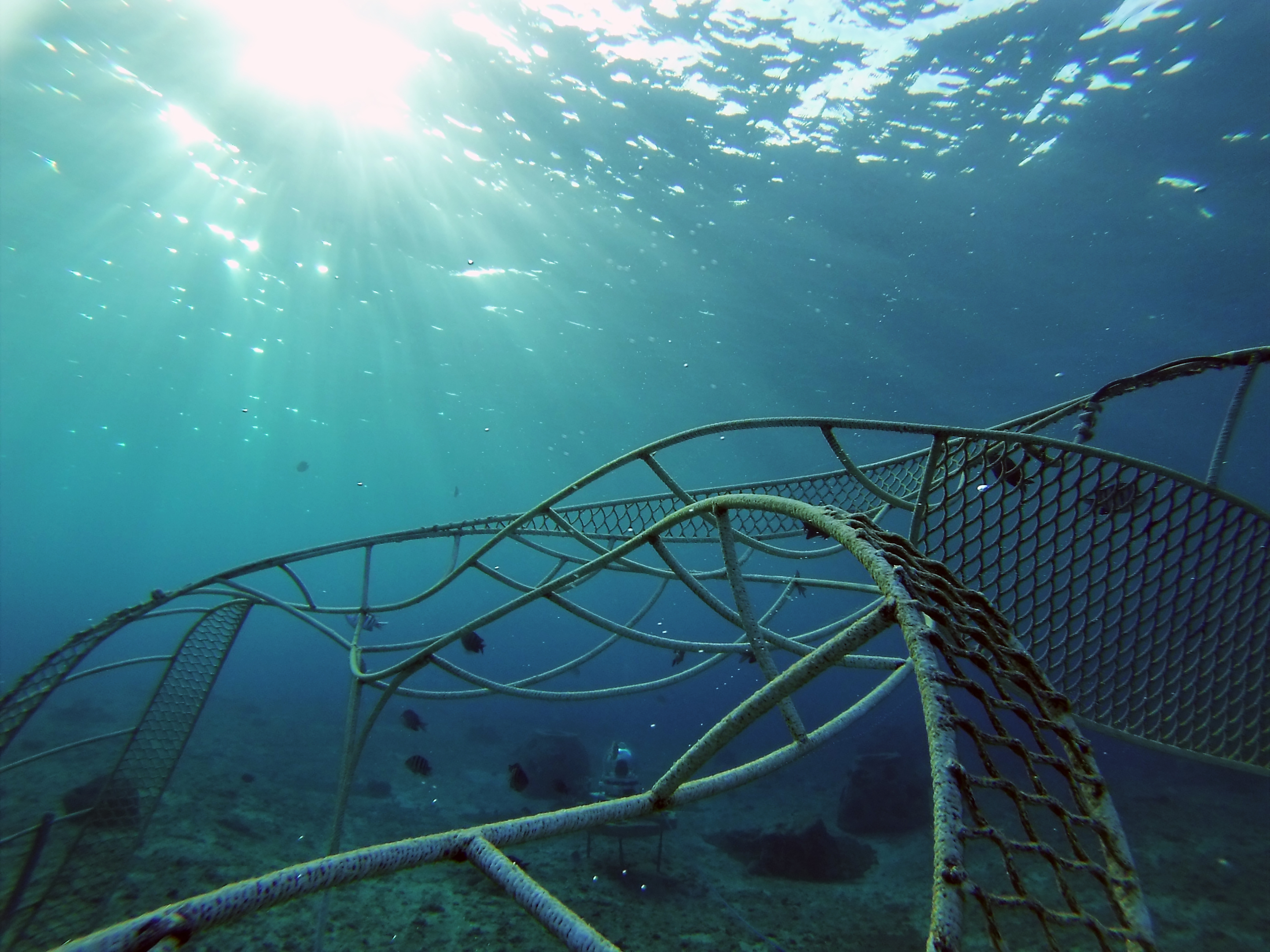Zoe means “life” in Greek. This DNA-inspired project is named in memory of Zoe Anderson, a young woman who wanted to save corals, and who tragically died from carbon monoxide poisoning. It’s a sad irony that carbon monoxide’s sister molecule, carbon dioxide, is threatening our entire planet and wiping out coral reefs globally.

Zoe – A Living Sea Sculpture is installed in Cozumel, Mexico, and disseminated worldwide via livestreaming webcam to provide a virtual aquarium day and night. We want to reach people who may never visit the sea, inspire curiosity, and create an intimate relationship with this wonderful water universe that we depend on for food, shore protection, clean water, recreation, medicine, and phenomenal wild beauty.
Low voltage electricity precipitates minerals to fortify the sculpture to become a strong, life supporting habitat for homeless corals and biodiversity in a region devastated by hurricanes, pollution, tourism, and climate change. Corals cement themselves to the calcifying structure and have been shown to grow faster and survive episodes of environmental stress. One theory is that they are receiving “free” calcium carbonate minerals to build their exoskeletons from the process, thus they have more energy for reproduction and other vital activities.
If we increase the ocean’s overall health by reducing plastics, pollutants, and unsustainable fishing, corals and other marine life will be more resilient to adapt and survive. As a memorial and coral refuge, this project uses the power of art, science, and technology to highlight life’s fragility and its promise. Nothing happens in a vacuum. If the ocean teaches us anything, it’s that everything is connected and we belong to the same planet and the same Universal Sea. It’s our job to create the conditions for life to flourish.
Watch the livestream of “Zoecam” here:
Submit your favorite screenshots or recordings here. Help us make more impact with our Virtual Aquarium. Games, international challenges, scientific research, and of course art and interactive projects…We love your stories and ideas!
Colleen Flanigan is a socio-ecological artist based in the US (New York, California, Oregon) and Mexico, where she is currently working on coral restoration efforts in the Mesoamerican Barrier Reef. Her background in Art, Craft, and Design include a BA in Design from UCLA (1993) and a post-bacc Degree in Metals from the Oregon College of Art and Craft (1997). An armaturist for stop-motion animation films, commercials, and TV with Will Winton Studios and LAIKA, Colleen created ball-and-socket and wire skeletons for the puppets in Coraline, the first feature-length, 3D stop-motion film based on Neil Gaiman’s same-titled book.
In 2011, with the confidence and community provided by a TED Senior Fellowship, she launched Living Sea Sculpture: Contemporary Art as Coral Refuge (now titled Zoe) on Kickstarter, and from there, the project, vision, and generous collaborators and sponsors have grown. More about Zoe, coral experiments, and Colleen’s plans for new reefscapes and underwater habitats are in this recent interview with SciArt Magazine about her work in SciArt Center’s exhibit, SUBMERGED.
Colleen has exhibited internationally in Bali, Europe, Mexico, Canada, and the United States. Now with this opportunity to co-create with Universal Sea, she proposes to use art, science, and technology to move more people from passive support to active engagement for ocean health and coral regeneration.
For her 3 actions: Imagine, every day you pass by structures and spaces created for us humans, but today is different. 1) You walk past an urban building with Zoe, an architectural collaboration with the sea, live streaming onto the entryway and animating the facade with fish and life aquatic. All species need shelter, places to sleep, gather, eat, and play, and today we make that visible. You walk through the ocean portal where you’ll be 2) transported to the tropics by a powerful documentary, Chasing Coral. After learning about the lives of our reef-building ancestors, their current plight, and some humans who are seeking solutions, we have a brief Q&A and prepare for next day’s hands-on workshop where we aim to bring people of all ages and backgrounds into deeper contact and empathy with marine life through making art.
Emerging technology is giving us new tools to highlight what matters to us through interactive, visceral experiences. More and more we’re able to explore remote places and express ourselves in Virtual Reality (VR). Domes are seductive, immersive environments. Perhaps our workshop is in a Planetarium if available. 3) Lying back you reflect upon a VR coral reef ecosystem projected across the curved surface reminding us of our orb(iting) planet. Individual cardboards to use with mobile phones will be handed out so you can personally experience being inside the 360 3D reef. Next, you wear the VR headset using Google’s Tilt Brush to create a coral, fish, or ocean creature to add to our VR Coral Reef. We aim to keep it going online as a fun, global way to focus attention on coral revitalization and bring new voices into the dialogue, verbal and visual, for ocean healing. In the workshops, let’s uncover how to link our Virtual Aquarium and VR Coral Reef to colonizing real world Living Sea Sculptures.
This project made possible in part by the Zoe Anderson Memorial Fund, the Harnisch Foundation, Gerry Ohrstrom, Vesper Foundation, Bertha Foundation, Sunset Restaurant and Bar, View into the Blue, Cozumel Scubafest, and nearly 500 private contributors via crowdfunding.
